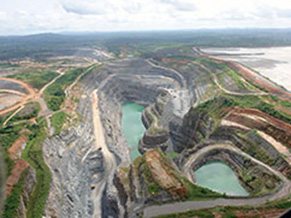
TWO newly unveiled gold projects – one by Gold Fields, the other by Harmony Gold – demonstrate the difficulty the world’s gold industry has in finding new sources of production following years of under-investment.
According to Leon Esterhuizen, an analyst for Nedbank Securities, Gold Fields’ Damang expansion in West Africa’s Ghana, is no dripping roast. Yet it does provide optionality against an expectation the gold price will continue to flourish.
The project sees Gold Fields invest $1.4bn over eight years in order to extend the Damang mine to 2024 from 2017 during which time some 1.56 million ounces of gold will be produced.
Crucial in the investment decision is a development agreement with the Ghanaian government that allows for a reduction in the corporate tax rate to 32.5% from 35% previously while the royalty rate was changed from a flat 5% of revenue to a sliding scale royalty based on the gold price.
Similarly, Harmony Gold’s $180m expansion of its Hidden Valley project in Papua New Guinea is not a project that jumps off the page; in fact, Harmony was until recently trying to sell the asset but couldn’t find a buyer.
It hopes to increase production at Hidden Valley to 180,000 oz/year as part of its wider ambition to lift group production 400,000 oz in three years to 1.5 million oz/year. The project will operate at an all-in sustaining cost (AISC) of less than $950/oz within the next three years, said Peter Steenkamp, CEO of Harmony.
But according to Nedbank data, projects operating at a cost of $950/oz are not hugely competitive. Of some 13 projects announced by South African gold mining companies over the last five to 10 years, ten operate at an AISC of below this level including Sibanye Gold’s Kloof decline project, west of Johannesburg, and the Kibali joint venture held between AngloGold Ashanti and Randgold Resources in the Democratic Republic of Congo.
He adds, however, that the capital expenditure at Damang is relatively low – which is a positive given the $1bn in debt on Gold Fields balance sheet – and that it’s likely to deliver a double digit internal rate of return. Also, organic growth – projects built ‘in the shadow of the headgear’ – are less risky than a greenfields development.
The point Esterhuizen makes, however, is that new gold projects are scarce owing to massive under-investment in finding new gold resources. (This factor, coupled with geopolitical uncertainty, low interest rates and sluggish global economic growth is likely to give impetus to the gold price).
The reason for the under-investment in the sector is fairly obvious. Since the gold price crash in 2011, gold mining companies have been focused on reducing debt which has meant very little investment in developing reserves. Greenfields exploration is almost non-existent among the large companies.
Gold Fields CEO, Nick Holland, said in a presentation to the Melbourne Mining Club in August that “… gold companies have not been spending enough to replace reserves, never mind grow them. As a result of under-spending and lower gold prices, reserve life has fallen from 24 years to 17 years in 2015”.
Said Esterhuizen: “We expect to see a lot more of these deals as well as industry wide consolidation, especially as the lack of capital investment continually squeezes this window of declining output ever more shut.
“This makes mining companies even more desperate to secure something that even remotely resembles some growth or at the very least keeps the optionality alive.
“It may be very true that a project should not be developed unless it delivers very good returns, but what if the project does not go ahead and the gold price then rises in two or three years from now?,” he said.








